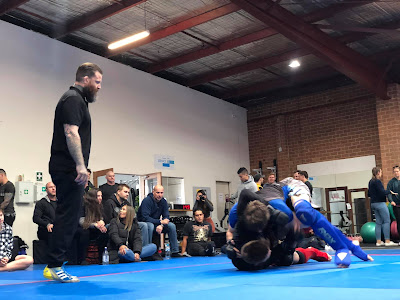We've been planning to run something like this for years and now finally felt the time was right. Over the years of training fighters we always felt that there were very limited opportunities for fighters to develop and get suitable competition experience in a way that prepared them for success in MMA.
The number one aim for our event was to provide a good avenue for fighters to gain competition experience in a way that would benefit them later in their fight career.
We were all very happy with how well the event ran and everyone who took part really enjoyed it and had great reviews,
We put a lot of work into the organisation of the event to ensure that it ran smoothly on the day and that everyone had a good experience.
Some of the things we focused on to make our event work well included.
A modified ruleset with No headshots. We were very clear about this in the lead-up and in the rules meeting before the matches. This rule-set is safer and means fighters can have several matches on one day. of course, it's going to feel different to fighting with headshots but the point is that fighters can gain valuable experience fighting under these modified rules that will serve them well when they do eventually progress onto fighting in pro-MMA rules,
We had several Fighters and Coaches say that they felt they would be at a disadvantage because they come from a kickboxing background and need to be able to strike to the head. In my opinion, the point isn't to win every match at this very early stage of your career. It is much more beneficial in the long term to gain valuable experience early in your competitive career and become a more well rounded and skilled fighter so that you don't get exposed later on in your career when the stakes are much higher.
I've always believed that the best career path for the long term athlete development of an MMA fighter is to compete in Grappling or BJJ tournaments as much as possible, compete in around 5 to 10 Amateur Boxing or kickboxing fights, compete in as many amateur (No headshot) MMA events as possible, then move on to Amateur MMA with head strikes and after 10 amateur MMA matches then you can fight under professional rules.
I believe this sort of long term plan is very important because too many fighters try to rush into pro rules MMA and then hope to learn on the job.
Another difference was that we made sure that all the referees and judges were experienced in MMA and or grappling so they understand the rules and were on top of the action at all times. This takes out a lot of the confusion and mistakes that I've seen in the past when you have kickboxing or boxing referees trying to understand what's happening on the ground during a fight.
We also made sure we were very clear on the rules meeting and that everyone knew exactly what was and wasn't allowed and the type of event we were trying to create. All fighters and teams stuck to the rules 100% and there was a great atmosphere.
Finally, we spent a lot of time making sure the format for the day was well organised and scheduled so there wasn't too much waiting around and less confusion about what's happening when. This, in turn, leads to less nerves for the fighters and overall and more enjoyable.
Overall Bushido #1 was a great success and we are already looking forward to running the next event on Saturday 1st February 2020.
Thanks again to everyone who helped out as judges, referees and staff. Thanks to all the fighters and teams who came along to take part and thanks to all the spectators who came along to support, Hope to see you all at the next one.
Check out our MMA Classes at DKMMA:




















